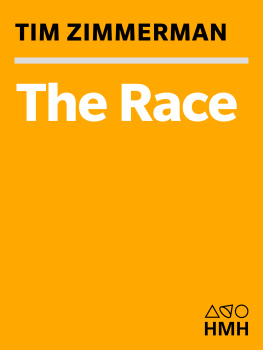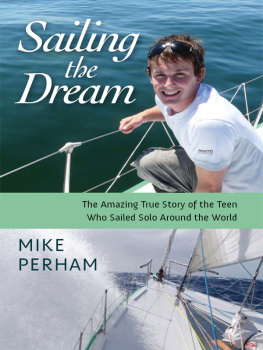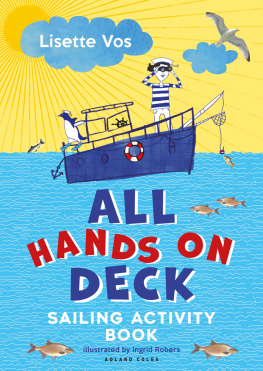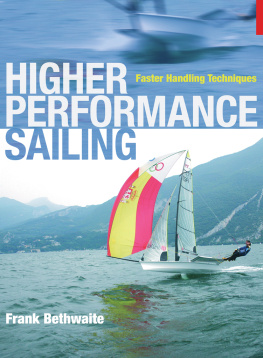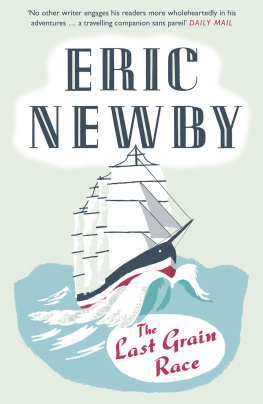Copyright 2002 by Tim Zimmermann
All rights reserved
For information about permission to reproduce selections from this book, write to or to Permissions, Houghton Mifflin Harcourt Publishing Company, 3 Park Avenue, 19th Floor, New York, New York 10016.
hmhbooks.com
Library of Congress Cataloging-in-Publication Data is available.
ISBN 0-618-11748-2
ISBN 978-0-618-38270-5 paperback
e ISBN 978-0-547-34706-6
This book is an independent account; it is not authorized or sponsored in any way by Bruno Peyron or The Race Event, SARL.
Bruno Peyron is the owner of the trademarks THE RACE and THE RACE logo. Any licensing inquiries should be directed to The Race Event, SARL, Paris, France.
For my grandfather,
who taught me the joys of sailing
And for Ilana,
who shares in the joys of life
No game was ever yet worth a rap
For a rational man to play
Into which no accident, no mishap,
Could possibly find its way.
Adam Lindsay Gordon
Acknowledgments
This book represents the work of many people. First and foremost, I owe thanks to the skippers who took part in The Race. Grant Dalton, Steve Fossett, Lock Peyron, Cam Lewis, and especially Skip Novak spent many hours patiently answering questions and recounting their experiences. Fossett and Dalton (along with his coskipper, Franck Proffit) helped me get a feel for the power and speed of their maxi-catamarans by welcoming me aboard for several outings. The PlayStation crewincluding Ben Wright, Brian Thompson, Stan Honey, Peter Hogg, Nick Moloney, Damian Foxall, Mark Callaghan, David Scully, and Tom Weaverwere gracious, humorous, and informative. Stuart Radnofsky was always willing to help arrange rides on the boat and track down far-flung sailors. The Club Med crewincluding Neal McDonald, Ed Danby, Mike Quilter, Steffano Rizzi, and Jan Dekkerwere equally accommodating when it came to educating a multihull neophyte. The cast of Team Philips Pete Goss, Mark Orr, Alex Bennett, Andy Hindley, Gary Venning, Vicky Bartholomew, and Patricia Juarezdemystified their fascinating Race design for me. Randy Smyth of Team Adventure explained the intricacies of driving a large catamaran in the Southern Ocean. With good humor and an eye for detail Rick Deppe, also of Team Adventure, answered endless questionssome obscure, some mundane, almost all randomon life at sea aboard a racing boat. The crew of Innovation Explorer Roger Nilson, Elena Caputo-Novak, Yves Loday, Julien Cressant, and othersalso provided essential information, in some cases tactfully overcoming my abysmal French, the international language of multihull racing.
Special thanks are also due to PlayStations, designers, Gino Morrelli and Pete Melvin. Pete spent considerable time walking me through the design of a maxi-catamaran from start to finish (and even offered to show me how to surf), and Gino filled in the gaps whenever I caught up with him in port or on the phone. Franck Martin of Multiplast also spent many hours explaining the development of the Oilier catamarans, and the yards David Palmer proved an invaluable and knowledgeable bridge to the French sailing world. Nigel Irens, one of the busiest multihull designers, added a crucial outsiders perspective from the pleasant vantage of a caf in Vannes.
Keeping up with the moving parts of The Racegetting in and out at the start in Barcelona and the finish in Marseilles with a wealth of information and details, a minimum of confusion, and plenty of good funwas the miraculous accomplishment of The Races press staff, headed by the tireless Mireille Vatine, assisted on the front lines by the inimitable Isabel Genis and the unflappable Bndicte Etienne. David Adams, a Race director, also gave me a better understanding of the operation and management of a worldwide competition.
You cant understand sailing without understanding, or at least trying to understand, the weather. Whatever insight I gained into that somewhat unknowable phenomenon I owe to Lee Bruce, who showed me how a person with a roomful of computers in Wolfeboro, New Hampshire, can peek at the weather thousands of miles away and accurately route a sailboat through and around storms and calms. Lee also contributed greatlyand generouslyto my depiction of Team Philips and her battle with the North Atlantic. On the other side of the globe, first from Sydney, Australia, then from Auckland, New Zealand, Roger Clouds Badham took time from his numerous forecasting commitments to guide me on Club Meds 27,000-mile voyage through the worlds major weather zones. Giles Chiorri, of Frances Mto Consult, also gave me his highly informed birds-eye view of the tactical war on the water, gleaned from his perch as weather consultant to The Race.
My thanks also to the hospitable staffs of Sailing World in Newport, Rhode Island, and Yachting World in London for letting me rummage through their magazine archives, which contained the colorfully told stories of many races long past. Trixie Wadson was a godsend when it came to tracking down photographs.
Most of all, this book could never have been started or finished without the enormously patient guidance and wise counsel of Bonnie Nadell at the Frederick Hill / Bonnie Nadell Literary Agency and of Eamon Dolan at Houghton Mifflin, so ably assisted by Emily Little. Larry Cooper, senior manuscript editor at Houghton, was a consummate pro and seemingly unfazed by any change or addition, no matter how small or how late. Whitney Peeling, senior publicist, was creative and impressively resourceful. Finally, nothing would have been possible without the generous and loving understanding of my wife, liana, who calmly negotiated all manifestations of stress, unburdened me of any chore she could take on, and provided a steady and soothing stream of encouragement when it was needed mostand even when it wasnt, which was nice too.
Introduction
I tell you naught for your comfort,
Yea, naught for your desire,
Save that the sky grows darker yet
And the sea rises higher.
G. K. Chesterton
A T FIRST it looked like a cloud, stretched low and benign along the horizon. From the helm of Team Adventure, a twin-hulled sailing catamaran hissing across the Southern Ocean, skipper Cam Lewis peered forward and muttered, What the hell is that? He took a distracted swipe at his goggles to clear the salt spray that 3 5-knot winds had speckled across the lens. He was rewarded with a glint of blue. Suddenly it wasnt a cloud at all. It was an iceberg, directly ahead. Team Adventure was closing at 30 knots, just minutes from a collision with the frozen mass.
Ice is one of the Southern Oceans most lethal and unpredictable dangers. Calving off the Antarctic ice pack, icebergs larger than Rhode Island sometimes wander hundreds of miles north into the shipping lanes around the bottom of the world, carried by fingers of current from the frozen Weddell and Ross Seas. The berg in Team Adventures way was a baby compared to some of the monsters recorded over the years, but massive nevertheless, perhaps four hundred feet long and one hundred feet high. Running into it would be like driving a bus into the side of an apartment building. That was not the only concern. Big icebergs often leave a trail of crumbling smaller chunks bobbing at the surface like floating mines. These growlers, some the size and weight of a minivan, are virtually invisible to radar and all but the sharpest lookout. At the speed Team Adventure was sailing, even a fifty-pound chunk of ice could shatter her brittle carbon-fiber skin or tear away a rudder. Anything bigger could rip her hulls right open, crippling her and stranding the fourteen-man crew halfway between Africa and South America, almost fifteen hundred miles from assistance.

